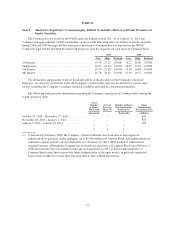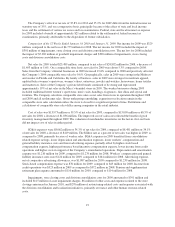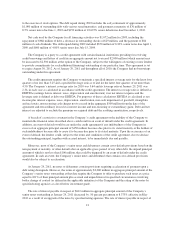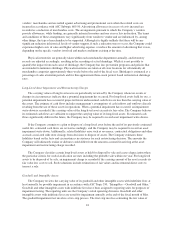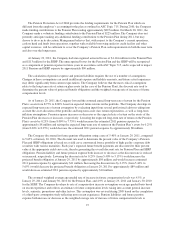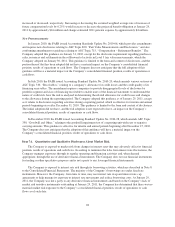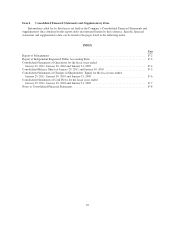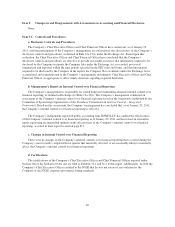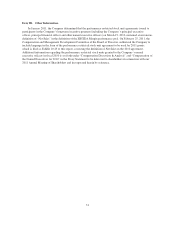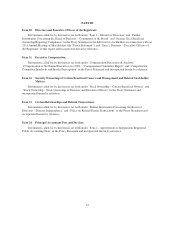Macy's 2010 Annual Report Download - page 29
Download and view the complete annual report
Please find page 29 of the 2010 Macy's annual report below. You can navigate through the pages in the report by either clicking on the pages listed below, or by using the keyword search tool below to find specific information within the annual report.funded status is affected by many factors including discount rates and the performance of Pension Plan assets. On
March 28, 2011, the Company made a voluntary funding contribution to the Pension Plan of $225 million. The
Company does not presently anticipate making any additional funding contributions to the Pension Plan during
2011, but may choose to do so in its discretion.
Management believes that, with respect to the Company’s current operations, cash on hand and funds from
operations, together with its credit facility and other capital resources, will be sufficient to cover the Company’s
reasonably foreseeable working capital, capital expenditure and debt service requirements and other cash
requirements in both the near term and over the longer term. The Company’s ability to generate funds from
operations may be affected by numerous factors, including general economic conditions and levels of consumer
confidence and demand; however, the Company expects to be able to manage its working capital levels and
capital expenditure amounts so as to maintain sufficient levels of liquidity. To the extent that the Company’s cash
balances from time to time exceed amounts that are needed to fund its immediate liquidity requirements, the
Company will consider alternative uses of some or all of such excess cash. Depending upon its actual and
anticipated sources and uses of liquidity, conditions in the capital markets and other factors, the Company will
from time to time consider the issuance of debt or other securities, or other possible capital markets transactions,
for the purpose of raising capital which could be used to refinance current indebtedness or for other corporate
purposes, and the redemption or repurchase of debt or other securities through open market purchases, privately
negotiated transactions or otherwise.
Management believes the department store business and other retail businesses will continue to consolidate.
The Company intends from time to time to consider additional acquisitions of, and investments in, department
stores and other complementary assets and companies. Acquisition transactions, if any, are expected to be
financed from one or more of the following sources: cash on hand, cash from operations, borrowings under
existing or new credit facilities and the issuance of long-term debt or other securities, including common stock.
Critical Accounting Policies
Merchandise Inventories
Merchandise inventories are valued at the lower of cost or market using the last-in, first-out (LIFO) retail
inventory method. Under the retail inventory method, inventory is segregated into departments of merchandise
having similar characteristics, and is stated at its current retail selling value. Inventory retail values are converted
to a cost basis by applying specific average cost factors for each merchandise department. Cost factors represent
the average cost-to-retail ratio for each merchandise department based on beginning inventory and the fiscal year
purchase activity. The retail inventory method inherently requires management judgments and contains
estimates, such as the amount and timing of permanent markdowns to clear unproductive or slow-moving
inventory, which may impact the ending inventory valuation as well as gross margins.
Permanent markdowns designated for clearance activity are recorded when the utility of the inventory has
diminished. Factors considered in the determination of permanent markdowns include current and anticipated
demand, customer preferences, age of the merchandise and fashion trends. When a decision is made to
permanently mark down merchandise, the resulting gross profit reduction is recognized in the period the
markdown is recorded.
The Company receives certain allowances from various vendors in support of the merchandise it purchases
for resale. The Company receives certain allowances as reimbursement for markdowns taken and/or to support
the gross margins earned in connection with the sales of merchandise. These allowances are generally credited to
cost of sales at the time the merchandise is sold in accordance with ASC Subtopic 605-50, “Customer Payments
and Incentives.” The Company also receives advertising allowances from more than 1,000 of its merchandise
vendors pursuant to cooperative advertising programs, with some vendors participating in multiple programs.
These allowances represent reimbursements by vendors of costs incurred by the Company to promote the
23


